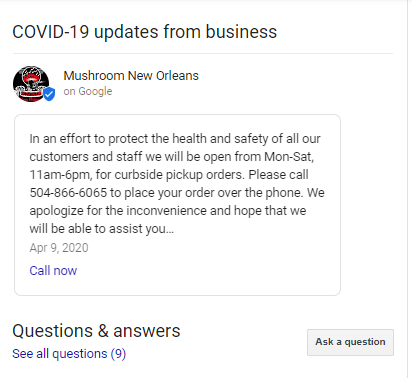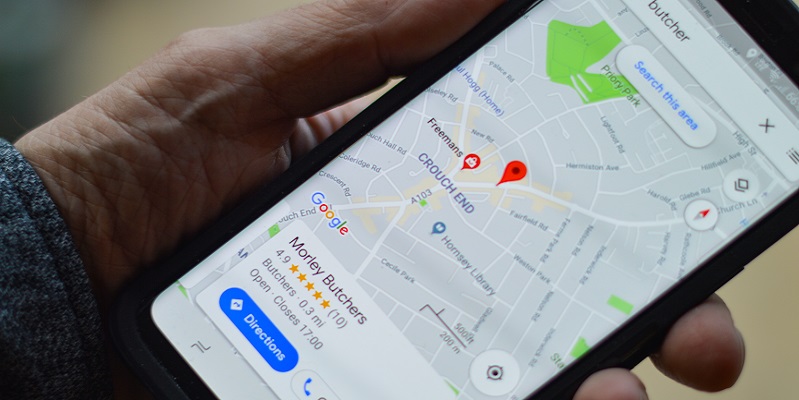It’s a good time for businesses to reassess their content marketing and SEO strategies in order to stay afloat during the pandemic.
How to navigate Google My Business and communicate with your customers more effectively during and after the pandemic.
In March and April of this year, more than 175,000 businesses in the U.S. shut down temporarily or permanently. In April, business closures surged by over 200% — an unprecedented slowdown of the U.S. economy.
Before the pandemic, only about 7% of U.S. workers regularly worked from home. Now, thanks to social distancing and shelter-in-place requirements, some two thirds of employees are working from home at least part of the week.
A Good Time to Review Your Local SEO and Content Optimization Strategy
Online traffic has exploded as businesses seek to maintain social distancing while still satisfying customers by embracing ecommerce, curbside pickup and delivery, and other newly relevant ways of doing business. Meanwhile, their customers are turning to social media daily as they try to figure out how to work remotely and buy remotely while staying safe.
This means that your customers are hungry for information on how your business is coping with the pandemic. It also means that search is more important than ever. To survive during the pandemic and after it finally fades, businesses need to take a fresh look at their content marketing and local SEO strategies.
Google Has Been Affected Too
For now, Google has limited its Google My Business (GMB) functionality, so be prepared for significant delays in getting support from the Google team. You’ll need a bit of patience to deal with all the changes.
So far, GMB has removed the Q&A, announced a delay in user reviews and pictures, and removed the ability to create short names. You’ll also see delays in publishing new listings or publishing edits of existing ones.
On the other hand, in early April Google assured users that “over the coming weeks, new user reviews, new user photos, new short names, and Q&A will be available. Their availability will gradually expand by country and business category.” So these limitations may change soon. Check your listings often.
How to Let Your Customers Know What You’re Up To
#1 Take advantage of dedicated COVID-19 posts and Google’s Temporarily Closed feature.
Take advantage of the dedicated area for COVID-19 updates from your business. This is a new type of post provided by Google. Pinned to the top of the knowledge panel, these posts are easily visible to persons searching for your business. Use them to keep your customers up to date about temporary closures, new operating hours, stock-related news, service changes, and precautions that your business is taking to ensure safety.

COVID-19 posts within the GMB dashboard provide an opportunity to let your customers know how you are keeping employees and the public safe while conducting business.
Not every business has access to this post feature. If your listing does not include it — perhaps because your primary category is a restricted one, like tobacco shops, accommodations, and casinos — you won’t see the option to make a COVID-19 post. In that case, we recommend updating your GMB description in order to get the COVID-19 information front and center. You can also use the Temporarily Closed feature; doing so will not hurt your ranking.
By staying alert during this fluid situation, and relevant in your Google posts, you can be very helpful to your customers.
#2 Update the homepage of your website.
Updating your homepage is another way to let your customers know about the changes your business is going through. At least add a pop-up with brief details about special hours, any safety measures you are taking, and other important details of your response to the pandemic. Be sensitive to the times across your content marketing strategy, understanding that your customers need coronavirus-relevant advice, recommendations, and information right now.
#3 Email regularly, but choose your messaging carefully.
In crisis mode, it’s especially important that email marketing provide relevant and timely content for your audience. Ensure that your messaging is sensitive to the current situation, is not overly playful, and does not take advantage of fears or negativity. But don’t be afraid to let your customers know what they can expect from your business. Have your hours changed? Are you offering curbside pick-up or delivery? Are you offering any sales or promotions to help customers save a little extra during this difficult time?
Email marketing over the next few months should provide clear and transparent communication regarding new or temporary policies, as well as logistical challenges like shipping delays, inventory shortages, and anything else that your customers would appreciate knowing. Use your email list to reassure customers that you are here for them, and here for them in a safe manner.
#4 Share your story with local media and neighborhood associations.
Does your business have a great story about how it’s helping neighbors, employees, or frontline workers? Can you do something that other businesses can’t? Get in touch with local media and neighborhood associations that are promoting stories of hope and unity and showcasing businesses doing their part to help. This also helps with link building!
One of SixEstate’s clients, Simply CBD, is a local retailer of hemp-derived CBD products with five stores across New Orleans. Since early March, Simply CBD has been providing personal protective equipment and hard-to-find supplies like disposable face masks, gloves, and hand sanitizer for customers as well as wholesaling them to businesses and donating products to local organizations. This enabled them to operate as an essential business, help their customers and community, and it led to some good media opportunities. Their story featured in Uptown Messenger is a prime example of hyperlocal media attention that has driven new customers to their businesses for curbside pickup of essential items.
#5 Follow local and federal guidelines to keep yourself safe, your employees safe, and your customers safe.
Most importantly, if you are operating your business in any capacity, you must follow local and federal recommendations for social distancing and other precautions to help keep everyone safe. Your customers depend on you for information and for your products. But they also depend on you to do everything you can to protect their health. The same goes for your employees, of course. Check the CDC’s regularly updated guide for businesses and employers responding to COVID-19 for strategies and recommendations.
Do you have questions about how to navigate local search or make the most effective marketing decisions during these unprecedented times? Contact us to talk strategy and learn how we can help.
